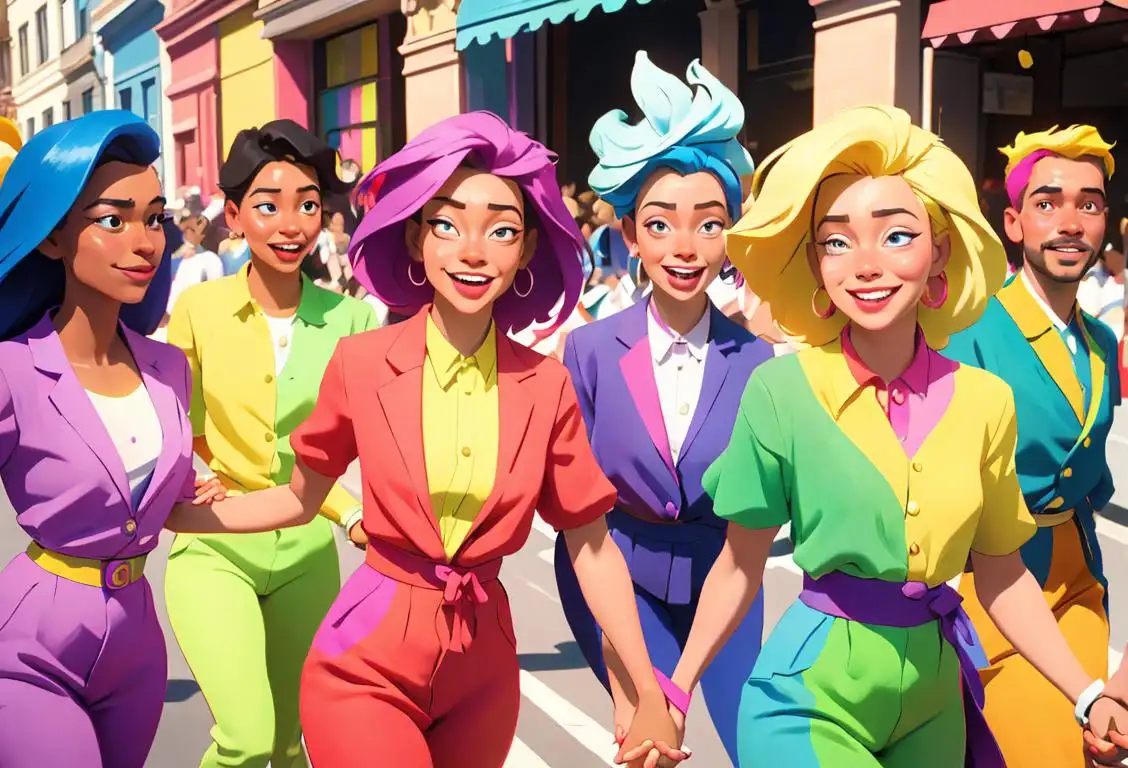National Pride Day

Hey there, prideful pals! Get ready to celebrate National Pride Day, a special day dedicated to embracing and promoting love, equality, and diversity in all its fabulous forms. It's a time to wave your rainbow flag high, bust out your brightest and boldest outfits, and join in the colorful festivities. Let's dive into the history of this joyous day and discover why it has become such an important celebration in our modern society.
When is Pride Day?
It's national pride day on the 15th August.
The Origin Story of National Pride Day
Picture this: It's the late 1960s, a period of intense social change and activism. A little place called Greenwich Village in New York City sparks a revolution that will become the foundation for the LGBTQ+ rights movement. The Stonewall Inn, a popular gay bar and safe haven, becomes the epicenter of a series of protests and demonstrations against police harassment and discrimination.
The year is 1969, and the LGBTQ+ community has had enough. One fateful summer night, after yet another violent police raid, the patrons of Stonewall Inn rise up, refusing to be silenced any longer. Their resilience and bravery ignite what history now recognizes as the Stonewall Riots or Stonewall Uprising, marking a turning point in the fight for LGBTQ+ rights.
Fast forward to 1970, when the first-ever Pride marches were organized in New York City, Los Angeles, Chicago, and San Francisco. These parades celebrated the one-year anniversary of the Stonewall Uprising and symbolized a collective resolve to demand equality, love, and acceptance. Over the years, Pride marches spread across the globe, uniting communities and bringing visibility to LGBTQ+ issues.
Celebrating Love, Equality, and Diversity
Today, National Pride Day continues to honor the legacy of those courageous individuals who fought for LGBTQ+ rights. It serves as a platform to celebrate the progress made and to highlight the work that still needs to be done. Pride events feature vibrant parades, concerts, parties, and educational activities. They bring together people from all walks of life, fostering a sense of unity, understanding, and acceptance.
National Pride Day is a reminder that love knows no boundaries, that everyone deserves respect and equal rights, regardless of their sexual orientation or gender identity. It's a day to stand proud, be authentic, and let our true colors shine.
History behind the term 'Pride'
1970
The Birth of LGBT Pride
The term 'pride' in the context of LGBT rights and activism can be traced back to the year 1970 when the first Pride marches were held in multiple cities in the United States. These marches were organized to commemorate the Stonewall riots that occurred the previous year, when LGBT patrons of the Stonewall Inn in New York City resisted a police raid. The marches aimed to promote visibility, acceptance, and pride in the diverse LGBT community.
1978
The Rainbow Flag Symbolizes Pride
In 1978, Gilbert Baker, an artist and LGBTQ activist, designed and created the iconic Rainbow Flag to be used as a symbol of pride and solidarity within the gay community. The flag was first unveiled at the San Francisco Gay Freedom Day Parade and quickly gained popularity as a visual representation of the LGBT pride movement. The rainbow colors came to symbolize diversity, equality, and inclusivity.
1999
Global Impact of Pride
The term 'pride' expanded beyond the borders of the United States as LGBTQ communities around the world began organizing their own Pride events. These events became significant milestones for LGBTQ rights and provided platforms for raising awareness, supporting one another, and advocating for equality. Pride celebrations are now held in numerous countries, with parades, festivals, and other activities becoming integral parts of the cultural calendars in cities worldwide.
2015
Marriage Equality Achievements
In 2015, the term 'pride' took on added significance when the Supreme Court of the United States ruled in favor of nationwide marriage equality, granting same-sex couples the legal right to marry in all 50 states. This landmark decision marked a major milestone in the fight for LGBTQ rights and provided a significant boost to the visibility and acceptance of the community. 'Pride' has since become associated with the achievements and ongoing struggles for equality and inclusion.
Present
Pride as a Global Symbol
Today, the term 'pride' has become synonymous with the LGBTQ rights movement and serves as a powerful symbol of resilience, self-acceptance, and the ongoing struggle for equality. Pride events have grown in size and importance, attracting millions of participants and allies worldwide. Beyond the annual celebrations, the term 'pride' has permeated popular culture, with rainbow flags appearing on products, buildings, and social media platforms to show support and solidarity with the LGBTQ community.
Did you know?
Did you know that the iconic rainbow flag, now synonymous with LGBTQ+ pride, was first created by artist and activist Gilbert Baker in 1978? Originally, the flag featured eight colors, each with a specific meaning. Over time, it was simplified to the six-color design we know and adore today. Red for life, orange for healing, yellow for sunlight, green for nature, blue for serenity, and purple for spirit. So, when you see those vibrant colors waving proudly during Pride celebrations, remember the powerful symbolism behind them!Tagged
awareness fun loved onesFirst identified
26th June 2015Most mentioned on
15th August 2020Total mentions
1073Other days
Compliment Day
Cheese Pizza Day
Pumpkin Day
Medal Of Honor Day
Guac Day
Foundation Day
Suicide Prevention Day
Memorial Day
Cancer Survivors Day
Bacon Day









